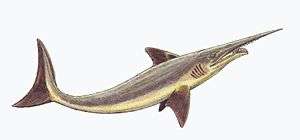Sarcoprion
| Sarcoprion Temporal range: Permian, 259–254 Ma | |
|---|---|
 | |
| Life restoration of Sarcoprion edax | |
| Scientific classification | |
| Kingdom: | Animalia |
| Phylum: | Chordata |
| Class: | Chondrichthyes |
| Order: | Eugeneodontida |
| Family: | Helicoprionidae |
| Genus: | Sarcoprion |
| Species | |
| |
Sarcoprion (Ancient Greek for "flesh saw") is an extinct genus of eugeneodontid holocephalid from the Permian of Greenland. Similar to other eugeneodontids like Edestus and Heliocoprion, it was best known for its extremely bizarre tooth morphology compared to other species of sharks and their closest relatives, the chimaeras. Compared to other members of Helicoprionidae (Teeth of Agassiz), its "tooth whorls" were found to be in sharper, more compact and in better condition than other sharks of the time, and refrained from growing to extremely unwieldy forms that would raise questions about its ability to feed properly.[1] The Genus contains one species, Sarcoprion edax ("gluttonous flesh saw"), found in Permian-aged marine strata of Meddelelser om Grønland.
Description
Sarcoprion had a jaw and mouth structure which allowed it to be more hydrodynamic, reducing the size and shape of the tooth whorl and increasing the size of the rostrum. Sarcoprion is thought to have pursued smaller, fast moving prey similar to today's Mako shark. Estimations on its size suggested an average of 6 meters (20 feet) from the two specimens discovered in Greenland.[2]
Paleobiology
Using the compact tooth whorl during hunting, Sarcoprion hunted a large variety of different species, diving at them with high speed and sawing vulnerable areas.[3] Any creatures that were wedged between its rostrum and its teeth were vertically thrashed to inflict maximum damage.
References
- ↑ http://2dgf.dk/xpdf/bull48-2-159-167.pdf Sarcoprion Nielsen, 1952
- ↑ http://fossilworks.org/bridge.pl?a=taxonInfo&taxon_no=248587
- ↑ A. Peter Kimley, 1996 ISBN 0-226-44249-7